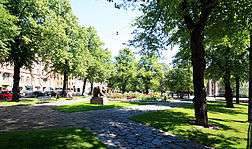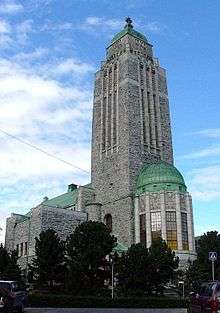Kallio
| Kallio Berghäll | |
|---|---|
| Helsinki Subdivision | |
 Position of Kallio within Helsinki | |
| Country |
|
| Region | Uusimaa |
| Sub-region | Greater Helsinki |
| Municipality | Helsinki |
| Subdivision number | 11 |
| District | Central |
| Subdivision regions | Linjat, Siltasaari, Torkkelinmäki |
| Area | 1.09 km2 (0.42 sq mi) |
| Population (2013) | 27,051 |
| • Density | 16,494/km2 (42,720/sq mi) |
| Postal codes | 00500, 00530 |
| Neighbouring subdivisions | Sörnäinen, Linjat, Harju |




Kallio (Swedish: Berghäll) is a district and a neighbourhood in Helsinki, the capital of Finland, located on the eastern side of the Helsinki peninsula about one kilometre north from the city centre. It is one of the most densely populated areas in Finland. Kallio (literally "the rock") is separated from the city centre by the Siltasaarensalmi strait, over which is a bridge called Pitkäsilta ("long bridge"). Traditionally, the bridge marks the symbolic divide between the bourgeois centre and the more working class areas around Kallio.
After the forming of the new centre in the 19th century, the city expanded northward. The intense industrialization which began in the 1860s in Helsinki saw the construction of the industrial areas around Sörnäinen harbour and to the workers' district of Kallio, with the area becoming inhabited mostly by factory workers. However, most of the working-class families have long ago been replaced as the most typical Kallio residents by young adults and elderly people living alone, in a process which could be seen as some sort of gentrification. For many people who move into Helsinki from elsewhere in Finland, Kallio is the area where they first settle. Most flats are small, and rents are typically lower than elsewhere in central Helsinki, partly explaining the area's popularity among students and artists. The small flat sizes also mean that Kallio is expected to resist full gentrification. However, the rents have increased as the district has grown more popular and become an increasingly desirable area to live in.

Kallio (and Harju, which is often considered a part of Kallio) also has, more than any other district in Helsinki, a reputation as a "bohemian" and liberal area. The area has a heterogeneous population and a large number of bars. The area also has a number of sex shops and strip joints.
President Tarja Halonen was born in Kallio and lived there until her election as president in 2000.
Street names
Five SE-NW streets of Kallio are named with Finnish ordinal numbers: Ensi linja, Toinen linja, Kolmas linja, Neljäs linja and Viides linja, meaning First Line, Second Line, Third Line, Fourth Line and Fifth Line, forming thus an example of numbered streets, rare in Europe and unique in Helsinki.
The SW–NE streets in the same area are named after Finnish scientists from the 18th and 19th century. Starting from South-east these include:
- Porthaninkatu, named after Henrik Gabriel Porthan, known as the Father of Finnish History.
- Suonionkatu, named after Julius Krohn, known by his pen name Suonio.
- Castréninkatu, named after Matthias Castrén, ethnologist and philologist.
- Wallininkatu, named after Georg August Wallin, orientalist and explorer.
To the east, the Torkkelinmäki area also has:
- Franzéninkatu, named after Frans Michael Franzén
- Agricolankatu, named after Mikael Agricola, reformator and the father of Finnish written language.
Many of the streets on both sides of Helsinginkatu in the Kallio and Harju are named after Swedish kings and lords of the 16th and 17th century
- Vaasankatu, named after the royal House of Vasa that ruled Sweden 1523-1654
- Kustaankatu, named after the first Vasa king Gustav I of Sweden, reign 1523-1560
- Kaarlenkatu, named after Charles IX of Sweden, reign 1604-1611
- Fleminginkatu, named after the Fleming family
- Sturenkatu, named after the Sture family
- Brahenkatu (eastern and western), named after the Brahe family
See also
External links
| Wikimedia Commons has media related to Kallio. |
- Baarikierros – This animated, mapped site lists and reviews most of the bars in Kallio.
Coordinates: 60°11′03″N 024°56′57″E / 60.18417°N 24.94917°E
